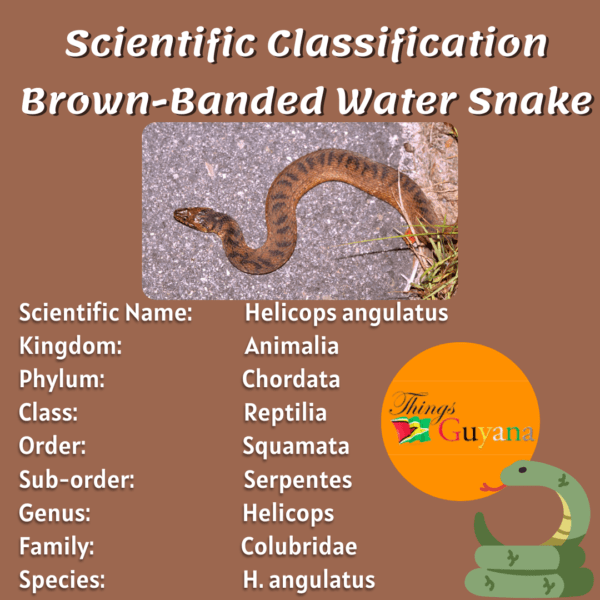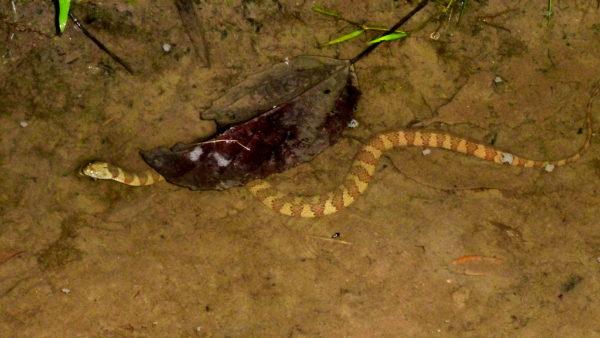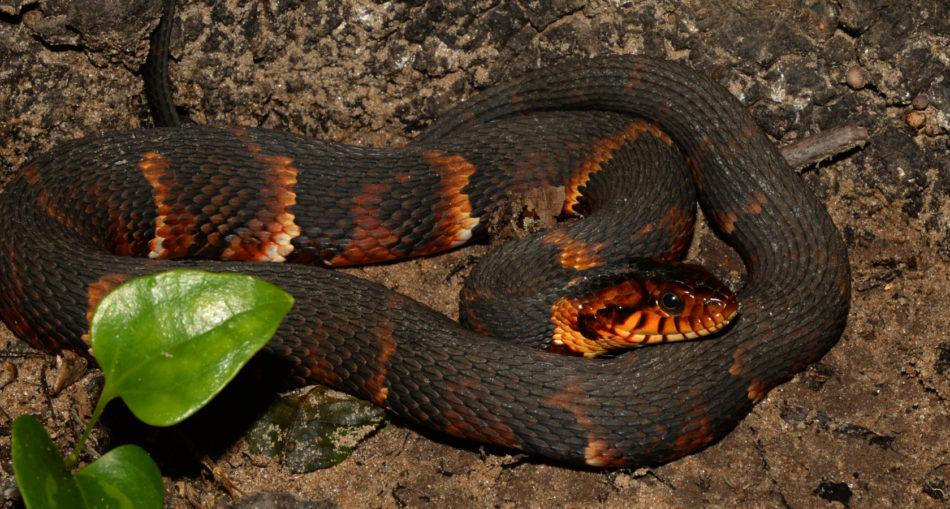I have seen many water snakes since I grew up in the rural regions of Guyana. Some I’ve seen dead and others while they were still alive. They would always fascinate me but, of course, my parents would warn me not to go anywhere near them since they are dangerous and could possibly kill me. The older I grew the more I realized how harmless they are to humans (and you will too after you finish reading this article) and are really more scared of us than we are of them. The brown-banded water snake is the most common water snake found in South America. They can reside both in water and on land.
Description
The Brown-banded Watersnake (Helicops angulatus) can be distinguished from most Amazonian snakes by having eyes and nostrils on top of the head. The pupil is round to semi-elliptical and the dorsum is grayish brown to olive brown with 21 to 25 dark transverse bands with black edges. The first dorsal band extends anteriorly in the middle into a tent-shaped mark. In terms of their appearance, they have a dark color that generally ranges from dark brown, black, and gray, to reddish-brown. Some also have splashes of yellow lining their bodies. As they grow older their bands would tend to disappear, leaving them with an all-black appearance.
Fun Fact: Some species of water-snakes may change colour and become lighter at night.

Etymology
The genus name Helicops, which derives from the Greek words helix, which means “turned,” and ops, which means “eye,” alludes to the orientation of this group of snakes’ eyes, which are inclined upward rather than outward. Angulatus, derived from the Latin words angulus, which means “angle,” and atus, which means “supplied with,” refers to the dorsal scales’ presence of conspicuous keels (scales that face downwards) that give the impression of numerous angles.
Habitat

Brown-banded water snake in habitat. Photo Source: https://www.flickr.com/photos/andreaskay/14607110109
Brown-branded water snake is a semi-aquatic snake situated in still freshwater bodies of water with abundant aquatic vegetation. It can also be found in streams, rivers, lakes, lagoons, fish ponds, and temporary ponds in open as well as forested areas with various degrees of human intervention. When in shallow waters, individuals usually have the body submerged and part of the head above the surface.
It is widely distributed throughout the Amazon basin in Bolivia, Brazil, Colombia, Ecuador, French Guiana, Guyana, Peru, Suriname, and Venezuela.
Fun Fact: They are nocturnal hunters but they can occasionally be seen during the daytime.
Diet
Brown-banded water snakes like to sit and wait for their prey, buried beneath the water with their head barely above, and when they spot something delicious they strike! Their diet includes mostly fish, but also amphibians (frogs, toads, and salamanders) in the adult stage as well as on their eggs and tadpoles.
Behaviour
When greeted with a threat the brown-banded water snake will create an S-coil with its body, open its mouth, and strike. When manipulated, individuals rotate the body, bite, and produce intestinal discharge. They can also use the tip of their tail as a weapon and poke their enemies. Sometimes it may tend to rear its head up to look as though it is highly venomous, this would warn predators to stay away. Because they are small, they have evolved to be very swift and whenever there is danger around they would quickly make their way into the water and bury themselves in the mud.
Venom
This species’ venom contains elements that are both neurotoxic (acting on the nervous system) and proteolytic, which break down proteins. When a human is bitten, they experience both changes in coagulation time and local discomfort.
Reproduction
In the spring, banded water snakes breed. After the approximately 79-day gestation period, females typically give birth to 9 to 50 live young. The young are self-sufficient from birth and measure 200–240 mm (or 8.0–9.5 in) in total length. At 2-3 years old, they are ready to reproduce.
Fun Fact: The baby snake is called a snakelet.
References:
https://www.reptilesofecuador.com/helicops_angulatus.html
https://en.wikipedia.org/wiki/Brown-banded_water_snake







